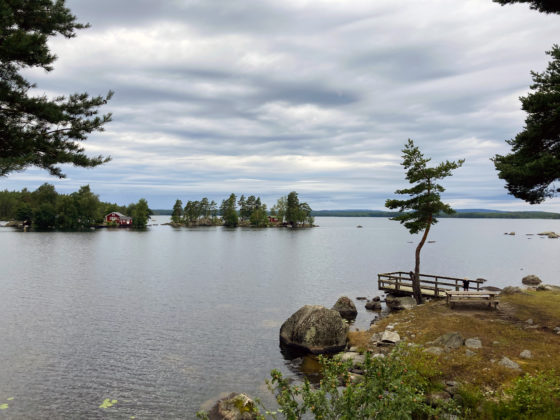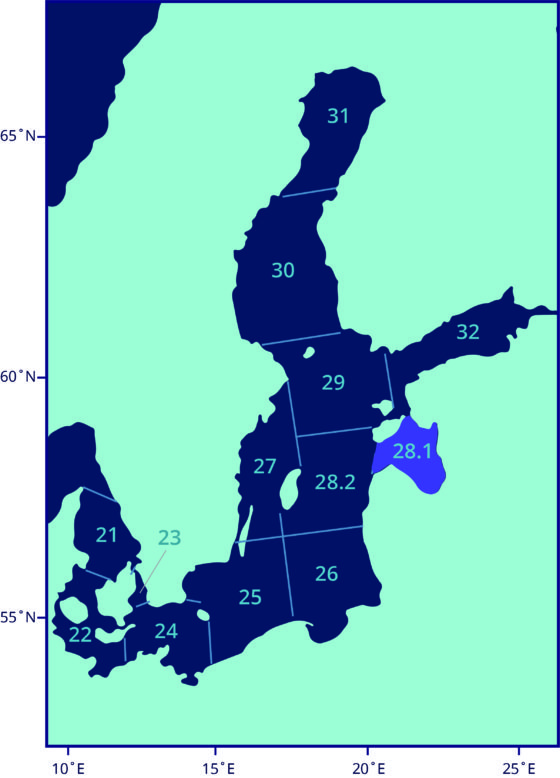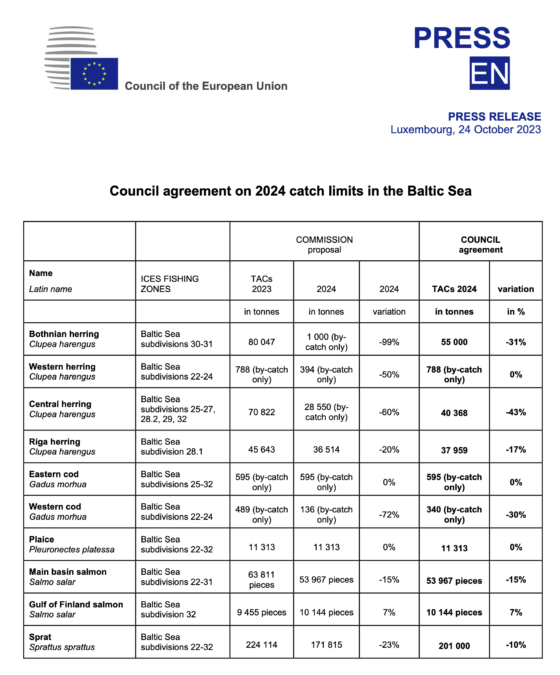
Yesterday at the Agrifish council meeting, fisheries ministers agreed on the Baltic Sea fishing opportunities for 2024. The Commission proposal, which emphasised the urgent need of precautionary measures for several fish stocks, was downplayed, leaving business as usual as the main outcome.
The most unsettling decisions concerned the Bothnian and Central Baltic herring populations. These stocks have deteriorated recently and ICES models show a very small chance of improvement even if fishing mortality is zero. In such a situation, the Baltic multiannual plan, which is a binding EU regulation, states that all fishing shall cease. In light of this, the Commission proposed a limited bycatch quota of 1 000 tonnes for Bothnian herring, and a more extensive one (28 550 tonnes) for Central Baltic herring. The substantially larger bycatch quota for the Central Baltic was motivated by the mixed industrial fishery for sprat and herring (on average a 60/40 mix1), thus allowing the sprat fishery to continue.
However, in the negotiations the legal requirements of the Baltic multiannual plan were disregarded. The outcome was a TAC for the Bothnian herring fishery of 55 000 tonnes – 55 times larger than proposed – and a TAC of 40 368 tonnes for Central Baltic herring; all to let the industrial fishing for fishmeal continue. This is a devastating decision for the herring and the wider Baltic Sea environment, as herring is one of the key species in the ecosystem providing food for other fish, mammals and birds. It is equally devastating for the small-scale coastal fisheries for herring that remain, such as the northern Swedish fishery supplying the traditional fermented herring production, which is already suffering from the stock decline.
The TAC agreed for the Western Baltic herring stock, which has been subjected to a zero catch advice for many years, was a rollover from last year of 788 tonnes. The only well managed herring stock in the Baltic, the Gulf of Riga herring, received a TAC of 37 959 tonnes.
For the first time in history, the TAC for the normally much larger Central Baltic herring population is basically equal to the TAC for the tiny Gulf of Riga herring – solid proof of the total failure of the joint management of the Central Baltic population. Meanwhile, Estonia and Latvia deserve a big applause for their fisheries management. To conclude, three out of four herring stocks in the Baltic Sea are in a critical state, and yet, a large outtake of fish will still be permitted next year.
For sprat, there is a 10% cut in permitted landings but the TAC remains at a massive 201 000 tonnes. This is worrying since the catches of sprat and herring are heavily mixed, at least in the central Baltic, and with a continued 60/40 mix would result in a herring catch of 80 400 tonnes – way above the agreed bycatch quota. The agreed TAC poses a real threat to the ailing herring stock, especially in light of widespread misreporting2.

The fishing sector in the tiny Gulf of Riga will be allowed to fish almost the same amount of herring as in the entire Central Baltic Sea, since the Riga herring is very well managed compared to all other Baltic herring stocks.
Mixed bag for other Baltic stocks
The Baltic Sea cod stocks are also in very bad condition, and no targeted fishing is allowed. For the first time ever, recreational fishing for Western Baltic cod is also prohibited. This underscores the severity of the situation. The bycatch-only TAC for the western cod stock was set at 340 tonnes, while for the eastern Baltic cod stock it was a rollover of the bycatch-only TAC of 595 tonnes. The TAC for plaice is also a rollover from last year, at 11 313 tonnes.
The agreed TAC for Baltic salmon in the main basin was a decrease of 15% to 53 976 salmons, while the TAC for salmon in the Gulf of Finland increased by 7% to 10 144 salmons.
Overall, the Council’s decisions signifies a clear return to business as usual, representing a major setback for the Baltic ecosystem, and a breach of European law.
1 ICES. 2023. Baltic Fisheries Assessment Working Group (WGBFAS). ICES Scientific Reports. 5:58. 606 pp. https://doi.org/10.17895/ices.pub.23123768, p 240
2 ICES. 2023. Herring (Clupea harengus) in subdivisions 25–29 and 32, excluding the Gulf of Riga (central Baltic Sea). Replacing advice provided in May 2023. In Report of the ICES Advisory Committee, 2023. ICES Advice 2023, her.27.25–2932: https://doi.org/ 10.17895/ices.advice.23310368, p 3.
ICES advice herring Central Baltic Sea 2023

Council agreement on fishing opportunities in the Baltic Sea 2024